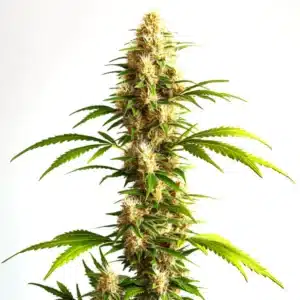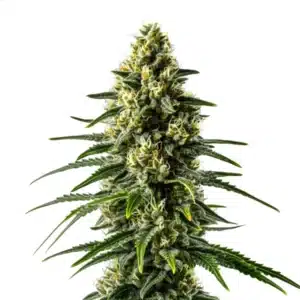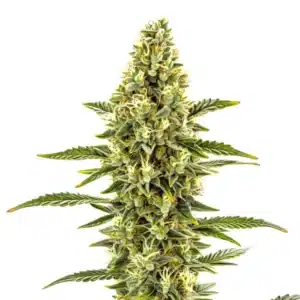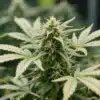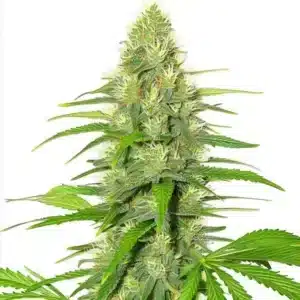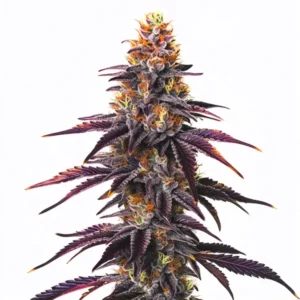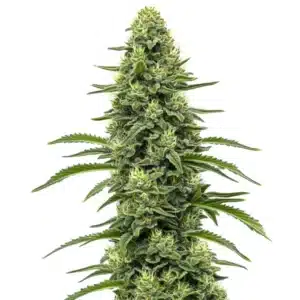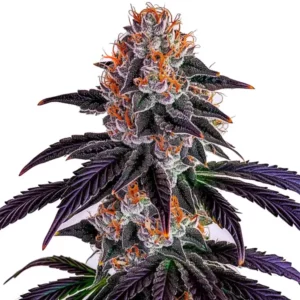
Chlorophyll Production and Nitrogen
Chlorophyll is the green pigment in plants responsible for photosynthesis. It’s what allows plants to absorb sunlight and turn it into energy. For cannabis growers, chlorophyll is crucial because it directly affects plant health and yield. But what many might not know is how closely linked chlorophyll production and nitrogen are.
Nitrogen is one of the primary nutrients plants need. It’s a major component of amino acids, the building blocks of proteins. In the context of chlorophyll production, nitrogen is indispensable. When nitrogen levels are optimal, chlorophyll synthesis is at its peak, leading to lush, green leaves. On the other hand, nitrogen deficiency can result in pale, yellowing leaves, signaling poor chlorophyll levels.
Recommended Strains
Blue Dream
|
|
THC | 17% - 24% (Medium) |
|
|
Type | Feminized |
|
|
Yield | High |
|
|
Phenotype | 50% Indica / 50% Sativa |
GG4
|
|
THC | 27% (High) |
|
|
Type | Feminized |
|
|
Yield | High |
|
|
Phenotype | 40% Indica / 60% Sativa |
For those growing cannabis, knowing the chlorophyll production and nitrogen relationship is key. A strain like Blue Dream thrives when nitrogen levels are just right. This strain is known for its impressive yield and vibrant color, both of which are supported by efficient chlorophyll production.
Impact of Nitrogen on Chlorophyll Synthesis
The impact of nitrogen on chlorophyll synthesis is profound. Think of nitrogen as the fuel for chlorophyll production. Without it, the whole process slows down. Plants will struggle to photosynthesize efficiently, which means less energy and slower growth. For cannabis cultivators, this can mean the difference between a thriving plant and one that barely survives.
Nitrogen is absorbed through the roots from the soil or nutrient solutions. Once inside, it plays a direct role in forming chlorophyll molecules. This is why growers often monitor nitrogen levels closely. Too little nitrogen and chlorophyll production drops. Too much, and you might face nutrient burn, leading to damaged leaves. Strains like Gorilla Glue #4 require balanced nitrogen to maintain their robust growth and potent yields.
Knowing the impact of nitrogen on chlorophyll synthesis allows growers to optimize plant health effectively. By maintaining appropriate nitrogen levels, plants can achieve maximum photosynthetic potential, ensuring energy is converted efficiently. Consistent nitrogen management leads to healthier, more productive plants, ultimately enhancing the quality and yield of the cannabis harvest.
Moreover, the chlorophyll production and nitrogen relationship is vital for achieving the desired plant vigor and resilience. Adjustments to nitrogen levels should be made with care, taking into account environmental factors such as light, temperature, and humidity, which can all influence nitrogen uptake and utilization. This holistic approach ensures that plants receive the necessary nutrients for optimal growth and development.
Promos & Deals
Nitrogen Deficiency Effects on Chlorophyll Levels
When cannabis plants face nitrogen deficiency, the effects on chlorophyll levels are noticeable. The first sign is often yellowing leaves, starting from the bottom of the plant. This happens because the plant prioritizes new growth, pulling nitrogen from older leaves, which reduces chlorophyll content.
In severe cases, nitrogen deficiency can stunt the plant’s growth, as photosynthesis becomes less efficient. Leaves might become brittle, and the plant may become more susceptible to diseases. For strains like White Widow, maintaining adequate nitrogen levels ensures the plant’s legendary resilience and potency.
Nitrogen deficiency effects on chlorophyll levels can lead to a decline in plant health, impacting overall yield and quality. Growers need to be vigilant in identifying the early signs of deficiency to prevent long-term damage. By addressing nitrogen deficiencies promptly, plants can recover more effectively, allowing chlorophyll production to return to optimal levels.
Regular soil testing and monitoring of nutrient solutions are critical in preventing nitrogen deficiency. This proactive approach helps ensure that plants receive the necessary nutrients to support healthy chlorophyll production and nitrogen levels. By maintaining a balanced nutrient regimen, growers can enhance plant vigor and achieve more consistent harvests.

Optimizing Chlorophyll Production with Nitrogen
Optimizing chlorophyll production with nitrogen involves striking the right balance. Over-fertilizing can be as detrimental as under-fertilizing. Start by testing your soil or nutrient solution to understand the current nitrogen levels. This will guide how much additional nitrogen you might need to add.
- Use a balanced fertilizer with a focus on nitrogen during the vegetative stage.
- Monitor plant responses closely and adjust as needed.
- Regularly check for signs of deficiency or excess.
- Consider the specific needs of your cannabis strain.
For many cannabis strains, the vegetative stage is when they require the most nitrogen. Adjust your feeding schedule accordingly, and remember that each strain might have slightly different needs. Some, like the Blue Dream, may require more nitrogen due to its vigorous growth patterns.
Optimizing chlorophyll production with nitrogen is critical for maximizing plant potential. By providing the right amount of nitrogen, growers can ensure that chlorophyll levels remain high, promoting energy absorption and photosynthesis. This leads to more robust plants that are better equipped to resist stress and produce higher yields.
The key to optimizing chlorophyll production and nitrogen levels lies in understanding the unique requirements of each cannabis strain. By tailoring nutrient regimens to specific growth stages and environmental conditions, growers can effectively manage nitrogen inputs, resulting in healthier, more productive plants.
Nitrogen’s Role in Chlorophyll Formation
Nitrogen’s role in chlorophyll formation cannot be understated. It is a core component of the chlorophyll molecule. Without it, the plant cannot produce the green pigment necessary for photosynthesis. This makes nitrogen one of the most critical nutrients in cannabis cultivation.
During chlorophyll formation, nitrogen combines with carbon, hydrogen, and oxygen to form chlorophyll molecules. This complex process is what gives plants their green color and allows them to absorb sunlight efficiently. For cannabis growers, ensuring a steady supply of nitrogen is vital for maintaining healthy chlorophyll levels.
- Test soil or nutrient solutions regularly.
- Choose fertilizers that match your plant’s growth stage.
- Observe plant health and adjust nutrient levels accordingly.
Knowing nitrogen’s role in chlorophyll formation helps growers make informed decisions about feeding schedules and nutrient mixes. This knowledge is invaluable when aiming to optimize plant health and boost yields.
By recognizing the importance of nitrogen in chlorophyll formation, growers can better manage their nutrient strategies to support plant health. Consistent monitoring and adjustment of nitrogen levels ensure that plants have the resources needed to produce chlorophyll efficiently, leading to vibrant, healthy growth.
Additionally, nitrogen’s role extends beyond chlorophyll formation to influence overall plant metabolism. Adequate nitrogen levels support the synthesis of essential proteins and enzymes, further contributing to the plant’s development and resistance to stressors. This holistic knowing of nitrogen’s impact enables growers to cultivate plants that thrive under various conditions.

FAQs
How does nitrogen deficiency affect cannabis plants?
Nitrogen deficiency in cannabis plants leads to several noticeable symptoms. The most obvious is yellowing leaves, which start from the bottom and work their way up. This occurs because the plant reallocates nitrogen from older leaves to support new growth. As a result, chlorophyll production decreases, impacting the plant’s ability to photosynthesize effectively.
Over time, nitrogen deficiency can stunt plant growth and reduce overall yield. The plant may also become more vulnerable to pests and diseases due to its weakened state. This is why monitoring and maintaining adequate nitrogen levels is crucial for any cannabis grower.
The nitrogen deficiency effects on chlorophyll levels are profound, as reduced chlorophyll impacts the plant’s energy production. Without sufficient nitrogen, the plant’s growth slows, and its overall vitality diminishes. Addressing nitrogen deficiencies promptly is essential to restore chlorophyll production and ensure healthy plant development.
Regular monitoring of nitrogen levels through soil tests or nutrient solution analyses helps growers identify potential deficiencies early. By adjusting nutrient regimens accordingly, growers can prevent long-term damage and maintain optimal chlorophyll production and nitrogen levels, resulting in healthier, more resilient plants.
What are the signs of nitrogen toxicity in cannabis?
Nitrogen toxicity can be just as problematic as a deficiency. The first sign is often dark green leaves, which may appear shiny or waxy. This is due to an excess of chlorophyll production, caused by too much nitrogen. Another common symptom is leaf tips curling down or developing a “claw-like” appearance.
If left unchecked, nitrogen toxicity can lead to nutrient burn, where leaf edges turn brown and crispy. This condition can hinder the plant’s growth and affect its overall health. To prevent this, adjust your feeding schedule and reduce nitrogen levels if you notice any symptoms of toxicity.
Managing nitrogen toxicity requires a careful approach to nutrient management. Reducing nitrogen inputs and flushing the growing medium with water can help alleviate symptoms and restore balance. By understanding the impact of nitrogen on chlorophyll synthesis, growers can avoid toxicity and ensure healthy plant development.
Monitoring plant responses is crucial in identifying and addressing nitrogen toxicity. By maintaining a balanced approach to nutrient management, growers can optimize chlorophyll production with nitrogen and prevent the adverse effects of excessive nutrient levels. This proactive strategy leads to healthier, more productive plants.
Can different strains require different nitrogen levels?
Yes, different cannabis strains can have varying nitrogen requirements. Factors such as growth rate, size, and genetic background all play a role in determining how much nitrogen a plant needs. For instance, fast-growing strains like Blue Dream may require more nitrogen to support their rapid development.
On the other hand, smaller or slower-growing strains might require less nitrogen. It’s important to tailor your nutrient regimen to the specific needs of the strain you’re cultivating. This ensures optimal chlorophyll production and overall plant health.
The chlorophyll production and nitrogen relationship varies among strains, highlighting the importance of understanding each strain’s unique requirements. By customizing nutrient strategies to suit individual strain characteristics, growers can maximize plant health and yield potential.
Regular observation of plant growth and development, along with soil and nutrient testing, helps growers fine-tune their nitrogen management strategies. This tailored approach ensures that each strain receives the necessary nutrients to support chlorophyll production and nitrogen utilization, resulting in vibrant, thriving plants.
How can I measure nitrogen levels in my grow setup?
Measuring nitrogen levels in your grow setup can be done through soil tests or by using nutrient solution testing kits. Soil tests provide information on the nutrient content of your growing medium, helping you determine if adjustments are needed. These kits are widely available and relatively easy to use.
For hydroponic or soilless systems, nutrient solution testing kits can give you a clear picture of nitrogen levels. These kits measure the concentration of nutrients in your water, allowing you to adjust nutrient mixes accordingly. Regular testing ensures that your plants receive the right amount of nitrogen for optimal growth.
Accurate measurement of nitrogen levels is crucial for optimizing chlorophyll production with nitrogen. By regularly testing and adjusting nutrient solutions, growers can ensure that plants have the resources needed to maintain healthy chlorophyll levels and promote vigorous growth.
Knowing nitrogen’s role in chlorophyll formation helps growers make informed decisions about nutrient management. By consistently monitoring nitrogen levels and adapting nutrient strategies, growers can optimize plant health and achieve higher yields.
What are natural ways to boost nitrogen levels for cannabis plants?
There are several natural ways to boost nitrogen levels for cannabis plants. Compost is an excellent source of nitrogen and can be added to the soil to enhance nutrient content. Composting organic materials like kitchen scraps and garden waste creates a nutrient-rich amendment for your growing medium.
Another option is using cover crops, such as clover or alfalfa, which fix nitrogen in the soil. These plants take nitrogen from the air and convert it into a form that plants can use. Incorporating them into your grow setup can help maintain healthy nitrogen levels naturally.
Natural methods of boosting nitrogen levels align with sustainable growing practices, promoting healthy chlorophyll production and nitrogen balance. By utilizing organic amendments and cover crops, growers can enhance nutrient content without relying on synthetic fertilizers.
These natural approaches not only support nitrogen levels but also improve soil health and structure. By fostering a thriving soil ecosystem, growers can enhance the availability of nutrients, optimize chlorophyll production, and promote robust plant growth.




